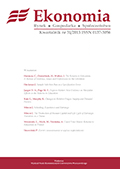Rynkowe miary konwergencji w europejskich krajach wschodzących w okresie zaburzeń na rynku finansowym
P. Mielus
ABSTRAKT:
Pełny tekst (PDF)
Numer wydania: 31
W numerze:
Rynkowe miary konwergencji w europejskich krajach wschodzących w okresie zaburzeń na rynku finansowym
P. Mielus
ABSTRAKT |
PDF
The article presents measures of convergence that can be implied from the
prices of instruments quoted on the financialmarket. Investors pricing off-balance
instruments on the derivativesmarket reveal their sentiment and level of
confidence related to the stability and development of the local market. Author
proposes the following measures of convergence observed both on interest
rate and currency market: convergence (forward) spread, basis swap, asset
swap, credit default swap, zero-delta straddle, risk reversal, butterfly and currency
spread. The financial crises of 2008–10 brought deconvergence processes
visible not only on emerging markets but also in some developed
eurozone countries. The presented derivative instruments offer valuable information
for all market analysts showing the level of convergence perceived
by active market participants.
Impact of Social Capital on Income
A. Grochowska, P. Strawiński
ABSTRAKT |
PDF
In this paper we attempt to quantify the impact of social capital on income. We
follow Putnam’s [1995] approach and we construct a synthetic index for social
capital using a multivariate probit model. Social capital is considered as one
of the crucial individual endowments, next to physical and human capital. In
a second step, we estimate the impact of the synthetically constructed social
capital index on an individual’s income using a Mincer-type earnings equation.
The results show that social capital explains up to 20% of income variation
both at the individual and household level. However, human capital and
physical capital remain the critical determinants of individual income.
Skumulowana teoria perspektywy jako model pomiaru racjonalności ekonomicznej
T. Potocki
ABSTRAKT |
PDF
Most economic models are prescriptive and based on expected utility theory.
Decisions taken on the basis of these models ought to be completely rational
and consistent with axioms of the expected utility theory. Prospect theory (PT)
is an alternative theory of choice under risk and increasingly used to explain
deviations from the traditional paradigm of rational agents. It is important to
understand the concept of the PT and its cumulative representation, as well as
how it is measured and whether and to what extent PT supports real decisions
under risk. This article explores these questions and deliver some axiomatic
research review of Cumulative Prospect Theory (CPT) as a framework for decision
under risk.
Technology convergence and digital divides. A country-level evidence for the period 2000–2010
E. Lechman
ABSTRAKT |
PDF
The paper, mostly empirical in nature, investigates issues on cross-national
new information and communication technologies (ICTs) adoption patterns
and growth directions.
In the period of 2000–2010, a great number of countries underwent substantial
changes on the field of ICTs implementation. Many of them made a great
“jump” starting with almost “zero level” of ICTs adoption in the year 2000 and
during the ten- year period were implementing ICTs at an astonishingly high
pace. Despite the obvious positive impact that ICTs have on overall society and
economy condition, rapid changes can also generate higher inequalities on the
field. The paper focuses mainly on capturing these changes. It also aims to confirm
or reject the hypothesis on growing inter-country inequalities in ICTs
adoption.
The target of the paper is twofold. Firstly, we explain the magnitude of past and
present differences in digitalization level among countries; secondly, we concentrate
digital technology convergence. We apply three approaches to convergence—
_-convergence, _-convergence and quantile-convergence (q-convergence),
to check if relative division between countries was growing or diminishing
in the time span of 2000 to 2010. Additionally, we check if countries of a given
sample tend to form convergence clubs in the relevant years.
The analysis is run for the sample consisted of 145 economies and the time coverage
is 2000–2010. All data applied in the research is drawn from the International
Telecommunication Union statistical databases [see www.itu.int].
Błędy popełniane w procesie podejmowania decyzji w świetle behawioralnej ekonomii finansowej
K. Zieliński
ABSTRAKT |
PDF
Przez długi czas nie podważanie zdolności ludzi do racjonalnego — zgodnego
z koncepcją homo oeconomicus, przeprowadzania procesów decyzyjnych
w warunkach niepewności, dzięki zaobserwowaniu częstych błędów popełnianych
w procesach podejmowania decyzji — systematycznych odchyleń od
wzorca wyznaczonego przez normatywną teorię oczekiwanej użyteczności, doprowadzi
ło do stworzenia przez Kahnemana i Tversky’ego deskryptywnej teorii
perspektywy, która, poprzez uwzględnienie aspektów psychologicznych,
wierniej odwzorowuje rzeczywiste zachowania jednostek. Przeprowadzone
badanie ankietowe weryfikuje istnienie ułomności założeń o racjonalności
w klasycznej teorii finansów, oraz wpływ aspektów psychologicznych na rzeczywiste
zachowania decydentów w procesie podejmowania decyzji.
Diagnoza działań promocyjnych polskich miast w opinii mieszkańców
M. Jankowska
ABSTRAKT |
PDF
The purpose of this paper is to analyze city dwellers’ opinions on their
hometowns’ promotional activities, taking into account the size of these urban
communities. The PAPI method (Paper and Pencil Interview) as well as an online
questionnaire were used to collect data. Standardized questionnaire was
used as a research tool. Polish city dwellers were surveyed between May 7th
and August 18, 2011. In addition, the author has compiled effectiveness evaluations
of the promotion tools used by the cities as collected by the inhabitants in
the framework of a TNS OBOP survey conducted in late October and early November
2010 on a sample of local community officials responsible for marketing.
An analogous comparison has been used to assess media effectiveness in
the cities’ promotion campaigns. This kind of compilation has led to identifying
differences in the reception of public image campaigns by those who run
them and those who are the target of the campaigns. That, in turn, can become
useful data for local communities’ bureaus of promotion to analyze.

